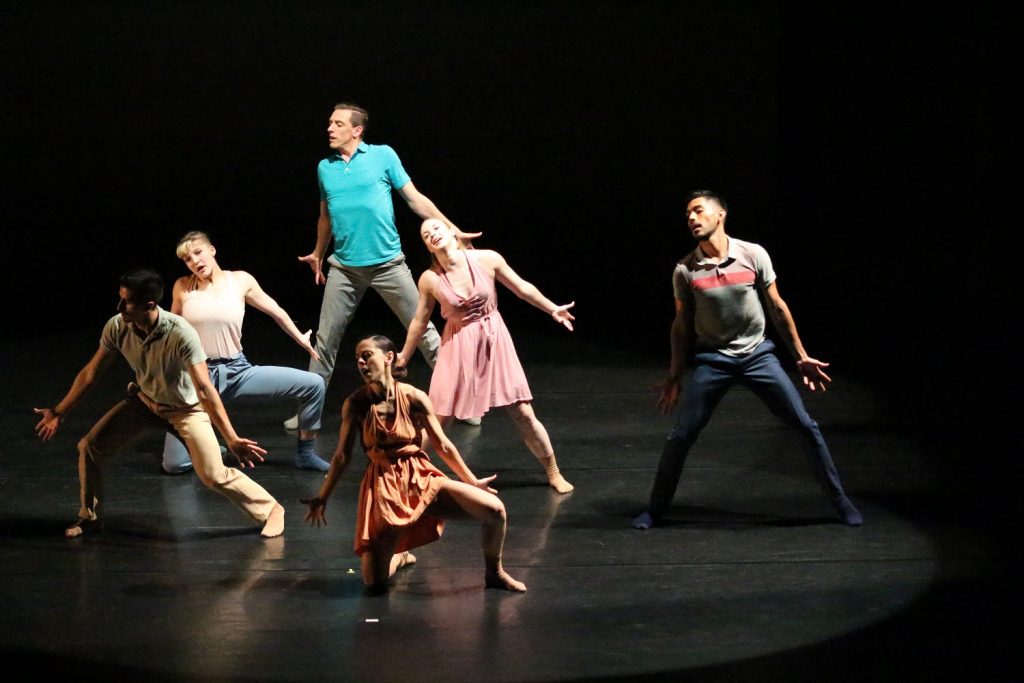I love an opportunity to visit Théâtre Raymond Kabbaz on a weeknight; in a charming, cozy alcove on Pico, the space is almost like a secret. Known only to local Francophiles and art-lovers, the curation there is unlike that of any other Los Angeles venue.
Last week’s offering there was one-night only, Kybele Dance Theater in three works. I had already seen multimedia film-and-live work Noir, which was paired with another dance film, Yol, and a much longer live work, DediKodu. Prior to the performance, I was pretty familiar with choreographer and director Seda Aybay’s work, as she actively teaches at Santa Monica College and performs with Kybele in Los Angeles and beyond.
I am impressed at how active she and her company have been in the last few years, especially with a lot of dancer turnover and the circumstances the community has faced. Kybele recently traveled to Chicago and Seoul, and Aybay is often collaborating with Carl Owens, who wrote and shot both films. But I found myself underwhelmed at the work that night, especially because it seemed to favor volume over quality.
Seeing Noir once before (in 2018) definitely tinted my experience of the latest iteration. With the exception of Aybay, the cast was entirely new, therefore pieces of the video had been re-shot so the onscreen dancers would match the live performance — but not all the characters lined up, only some. Pulpy detective hero Dick narrated the film from the first person, as the protagonist. But onscreen he was played by an entirely different dancer than onstage, which made little sense.
Beyond the casting, the writing laid groundwork for a piece that referenced the classic noir films beloved in our city. But it was so referential that it became entirely trope, lacking body and even reducing the characters to two-dimensional. Disjointed sound mixing and film quality made the narrative even harder to believe. Aybay’s choreography hadn’t changed much either, and I couldn’t help but feel that the chance to reinvent the work on new personalities was lost.
The dancers (Maoka Doi, Holly Diehl, Karl Ramirez, Andrii Strelkivskyi, and Rob Wells) were clearly all very capable, each finding motivation in the movement and working hard to knit the movements together. Having taken Aybay’s class, I know that her choreography is not easy, and it really does favor the technician. She’s incredibly strong and her vision is specific. But the movement did not suit the dancers well, forcing them to fight against momentum for what appeared to me little visual reward.
Yol was somewhat opposite, a focus on high-quality close-up film angles. While I don’t think the work necessarily required narrative, the motivation to her movements seemed vague and somehow overproduced. After each film, a behind-the-scenes video played where Aybay and Owens described their processes. While I’m normally itching to study the context of a stage work, it felt like odd placement, disrupting the magic of the theatrical presentation.
DediKodu closed the evening, the title Turkish for “gossip,” which was illustrated through every possible combination of dancers onstage: solos, duets, trios, the whole company in unison. The vocabulary and shape of the piece seemed to me particularly derivative of a certain other choreographer, who I won’t name here — and even if it wasn’t, it was drawn out far too long.
Chopped-up dialogue from each dancer played over their solo, mixed repetitively into a looping piece of music that would never end. The artists performed well in these moments, especially unbound by the constraints of unison, and Holly Diehl stood out as the only dancer to actually speak her monologue while dancing it, filling out the moments in between her steps with grace and animation.
The dancers grew tired from wrestling the choreography, and the piece began to feel more like it was reaching to meet a time quota rather than reach a natural conclusion. There were a few moments of beauty, where innovative lifts or transitions found a fleeting spotlight. All things considered, though, the movement vocabulary was fragmented and laden with unnecessary developpés. I found it unoriginal, which is not always a bad thing. But it all blended into itself by the end of the night, which was difficult to parse.
It’s hard to fault an artist for one slow night, where it was clear that rehearsal time was running low and perhaps energy was too. But I hope to see Kybele share a more finished piece of work in the future, something that really does these beautiful dancers justice.
For more information about Kybele Dance Theater, please visit their website.
For more information about the Théâtre Raymond Kabbaz, please visit their website.
Written by Celine Kiner for LA Dance Chronicle.
Featured image: Kybele Dance Theater – DediKodu choreography by Seda Abay – Photo by Yoshi Taniyama








